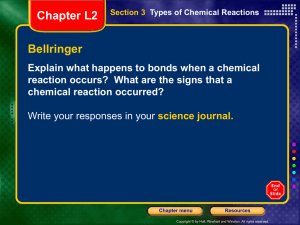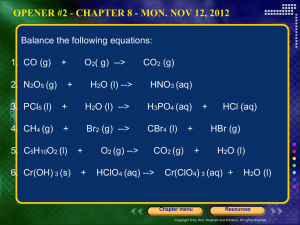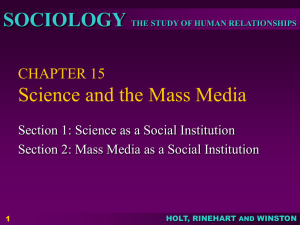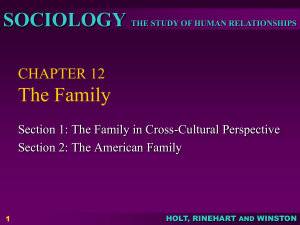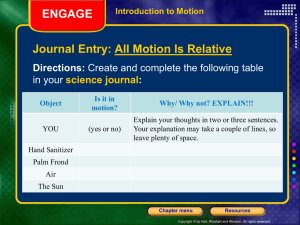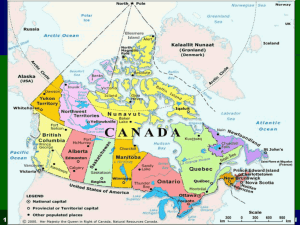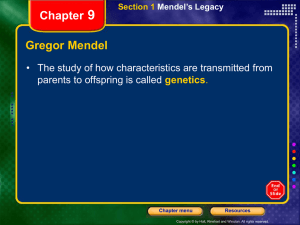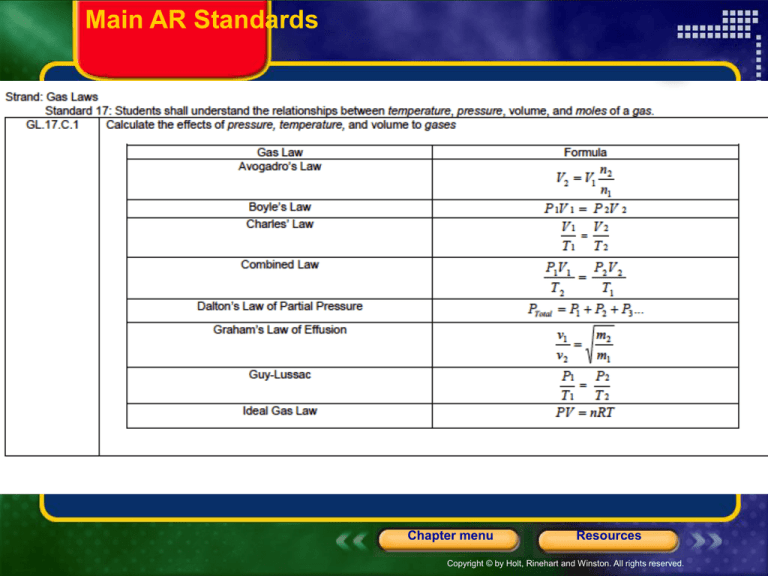
Main AR Standards
Chapter menu
Resources
Copyright © by Holt, Rinehart and Winston. All rights reserved.
AR STANDARDS for ch. 10-11
Chapter menu
Resources
Copyright © by Holt, Rinehart and Winston. All rights reserved.
Chapter 11
Gases
Table of Contents
Section 3 Gas Volumes and the Ideal Gas Law
Chapter menu
Resources
Copyright © by Holt, Rinehart and Winston. All rights reserved.
Chapter 11
Section 3 Gas Volumes and the Ideal
Gas Law
Objectives
• State the law of combining volumes.
• State Avogadro’s law and explain its significance.
• Define standard molar volume of a gas and use it to
calculate gas masses and volumes.
• State the ideal gas law.
• Using the ideal gas law, calculate pressure, volume,
temperature, or amount of gas when the other three
quantities are known.
Chapter menu
Resources
Copyright © by Holt, Rinehart and Winston. All rights reserved.
Chapter 11
Section 3 Gas Volumes and the Ideal
Gas Law
Measuring and Comparing the Volumes of
Reacting Gases
• In the early 1800s, French chemist Joseph GayLussac observed that 2 L of hydrogen can react with
1 L of oxygen to form 2 L of water vapor.
hydrogen gas + oxygen gas water vapor
2 L (2 volumes) 1 L (1 volume) 2 L (2 volumes)
• The reaction shows a simple 2:1:2 ratio in the
volumes of reactants and products. This same ratio
applies to any volume proportions: for example,
2 mL, 1 mL, and 2 mL; or 600 L, 300 L, and 600 L.
Chapter menu
Resources
Copyright © by Holt, Rinehart and Winston. All rights reserved.
Chapter 11
Section 3 Gas Volumes and the Ideal
Gas Law
Measuring and Comparing the Volumes of
Reacting Gases
• The same simple and definite volume proportions can
be observed in other gas reactions.
hydrogen gas + chlorine gas hydrogen chloride gas
1 L (2 volumes) 1 L (1 volume)
2 L (2 volumes)
• Gay-Lussac’s law of combining volumes of gases
states that at constant temperature and pressure, the
volumes of gaseous reactants and products can be
expressed as ratios of small whole numbers.
Chapter menu
Resources
Copyright © by Holt, Rinehart and Winston. All rights reserved.
Chapter 11
Visual Concepts
Gay-Lussac’s Law of Combining Volumes of
Gases
Click below to watch the Visual Concept.
http://my.hrw.com/sh/hc6_003036809x/student/
Visual Concept
ch11/sec03/vc00/hc611_03_v00fs.htm
Chapter menu
Resources
Copyright © by Holt, Rinehart and Winston. All rights reserved.
Chapter 11
Section 3 Gas Volumes and the Ideal
Gas Law
Avogadro’s Law
• In 1811, Amedeo Avogadro explained Gay-Lussac’s law
of combining volumes of gases without violating
Dalton’s idea of indivisible atoms.
• Avogadro reasoned that, instead of always being in
monatomic form when they combine to form products,
gas molecules can contain more than one atom.
• He also stated an idea known today as Avogadro’s
law. The law states that equal volumes of gases at
the same temperature and pressure contain equal
numbers of molecules.
Chapter menu
Resources
Copyright © by Holt, Rinehart and Winston. All rights reserved.
Chapter 11
Visual Concepts
Avogadro’s Law
Click below to watch the Visual Concept.
http://my.hrw.com/sh/hc6_003036809
Visual Concept
x/student/ch11/sec03/vc03/hc611_03
_v03fs.htm
Chapter menu
Resources
Copyright © by Holt, Rinehart and Winston. All rights reserved.
Chapter 11
Section 3 Gas Volumes and the Ideal
Gas Law
Avogadro’s Law, continued
• Avogadro’s law also indicates that gas volume is
directly proportional to the amount of gas, at a given
temperature and pressure.
• The equation for this relationship is shown below,
where V is the volume, k is a constant, and n is the
amount of moles of the gas.
V = kn
Chapter menu
Resources
Copyright © by Holt, Rinehart and Winston. All rights reserved.
Chapter 11
Section 3 Gas Volumes and the Ideal
Gas Law
Avogadro’s Law, continued
• Avogadro’s law applies to the combining volumes in
gas reactions, and helped him to deduce chemical
formulas in reactions.
• Dalton had guessed that the formula for water
was HO, but Avogadro’s reasoning established
that water must contain twice as many H atoms as
O atoms because of the volume ratios in which the
gases combine:
hydrogen gas + oxygen gas water vapor
2 L (2 volumes) 1 L (1 volume) 2 L (2 volumes)
Chapter menu
Resources
Copyright © by Holt, Rinehart and Winston. All rights reserved.
Chapter 11
Section 3 Gas Volumes and the Ideal
Gas Law
Avogadro’s Law, continued
• Given Avogadro’s law, the simplest possible chemical
formula for a water molecule indicated two hydrogen
atoms and one oxygen atom.
hydrogen gas + oxygen gas water vapor
(2 volumes)
(1 volume)
(2 volumes)
2H2 (g) O2 (g) 2H2O(g)
• Avogadro’s idea that some gases, such as hydrogen and
oxygen, must be diatomic, was thus consistent with Avogadro’s
law and a chemical formula for water of H2O.
Chapter menu
Resources
Copyright © by Holt, Rinehart and Winston. All rights reserved.
Chapter 11
Visual Concepts
Using Gay-Lussac’s Law of Combining Volumes of
Gases and Avogadro’s Law to Find Mole Ratios
Click below to watch the Visual Concept.
http://my.hrw.com/sh/hc6_003036809x/student/ch
Visual Concept
11/sec03/vc05/hc611_03_v05fs.htm
Chapter menu
Resources
Copyright © by Holt, Rinehart and Winston. All rights reserved.
Chapter 11
Section 3 Gas Volumes and the Ideal
Gas Law
Molar Volume of a Gas
• Recall that one mole of a substance contains a number of
particles equal to Avogadro’s constant (6.022 1023).
• example: one mole of oxygen, O2, contains 6.022 1023 diatomic
molecules.
• According to Avogadro’s law, one mole of any gas will occupy the
same volume as one mole of any other gas at the same
conditions, despite mass differences.
• The volume occupied by one mole of gas at STP is known as the
standard molar volume of a gas,
which is 24.414 10 L (rounded to 22.4 L).
Chapter menu
Resources
Copyright © by Holt, Rinehart and Winston. All rights reserved.
Chapter 11
Section 3 Gas Volumes and the Ideal
Gas Law
Molar Volume of a Gas, continued
• Knowing the volume of a gas, you can use the
conversion factor 1 mol/22.4 L to find the moles (and
therefore also mass) of a given volume of gas at STP.
• example: at STP,
1 mol
5.00 L of gas
0.223 mol of gas
22.4 L
• You can also use the molar volume of a gas to find
the volume, at STP, of a known number of moles or a
known mass of gas.
• example: at STP,
0.768 mol of gas
22.4 L
17.2 L of gas
1 mol
Chapter menu
Resources
Copyright © by Holt, Rinehart and Winston. All rights reserved.
Chapter 11
Section 3 Gas Volumes and the Ideal
Gas Law
Molar Volume of a Gas, continued
Sample Problem G
What volume does 0.0685 mol of gas occupy at STP?
What quantity of gas, in moles, is contained in 2.21 L at
STP?
Chapter menu
Resources
Copyright © by Holt, Rinehart and Winston. All rights reserved.
Chapter 11
Section 3 Gas Volumes and the Ideal
Gas Law
Molar Volume of a Gas, continued
Sample Problem G Solution
a.
Given: 0.0865 mol of gas at STP
Unknown: volume of gas
Solution: Multiply the amount in moles by the
conversion factor, 22.4 L.
1 mol
22.4 L
0.0685 mol of gas
1.53 L of gas
1 mol
Chapter menu
Resources
Copyright © by Holt, Rinehart and Winston. All rights reserved.
Chapter 11
Section 3 Gas Volumes and the Ideal
Gas Law
Molar Volume of a Gas, continued
Sample Problem G Solution, continued
b.
Given: 2.21 L of gas at STP
Unknown: moles of gas
Solution: Multiply the volume in liters by the conversion
factor, 1 mol .
22.4 L
1 mol
2.21 L of gas
0.0987 mol of gas
22.4 L
Chapter menu
Resources
Copyright © by Holt, Rinehart and Winston. All rights reserved.
Practice Problems pg. 381
Complete practice problems pg. 381 #1-2 and show all
work.
Chapter menu
Resources
Copyright © by Holt, Rinehart and Winston. All rights reserved.
ANSWERS
Practice Problems pg. 381
Complete practice problems pg. 381 #1-2 and show all
work.
Chapter menu
Resources
Copyright © by Holt, Rinehart and Winston. All rights reserved.
Chapter 11
Section 3 Gas Volumes and the Ideal
Gas Law
Gas Stoichiometry
• Gay-Lussac’s law of combining volumes of gases and Avogadro’s
law can be applied in calculating the stoichiometry of reactions
involving gases.
• The coefficients in chemical equations of gas reactions reflect not
only molar ratios, but also volume ratios (assuming conditions
remain the same).
• example—reaction of carbon dioxide formation:
2CO(g) + O2(g) 2CO2(g)
2 molecules
2 mole
2 volumes
1 molecule
1 mole
1 volume
2 molecules
2 mol
2 volumes
Chapter menu
Resources
Copyright © by Holt, Rinehart and Winston. All rights reserved.
Chapter 11
Section 3 Gas Volumes and the Ideal
Gas Law
Gas Stoichiometry, continued
2CO(g)
+
O2(g)
2CO2(g)
2 molecules
1 molecule
2 molecules
2 mole
1 mole
2 mol
2 volumes
1 volume
2 volumes
• You can use the volume ratios as conversion
factors in gas stoichiometry problems as you would
mole ratios:
1 volume O2
2 volumes CO
or
1 volume O2
2 volumes CO
2 volumes CO2
2 volumes CO
or
2 volumes CO2
2 volumes CO
etc….
Chapter menu
Resources
Copyright © by Holt, Rinehart and Winston. All rights reserved.
Chapter 11
Visual Concepts
Gas Stoichiometry
Click below to watch the Visual Concept.
Is this the right videoclip - didn’t see gas stoichiometry.
http://my.hrw.com/sh/hc6_0030368
Visual Concept
09x/student/ch11/sec03/vc02/hc611
_03_v02fs.htm
Chapter menu
Resources
Copyright © by Holt, Rinehart and Winston. All rights reserved.
Chapter 11
Section 3 Gas Volumes and the Ideal
Gas Law
Gas Stoichiometry, continued
Sample Problem H
Propane, C3H8, is a gas that is sometimes used as a fuel
for cooking and heating. The complete combustion of
propane occurs according to the following balanced
equation.
C3H8(g) + 5O2(g) 3CO2(g) + 4H2O(g)
(a) What will be the volume, in liters, of oxygen required
for the complete combustion of 0.350 L of propane?
(b) What will be the volume of carbon dioxide produced
in the reaction? Assume that all volume measurements
are made at the same temperature and pressure.
Chapter menu
Resources
Copyright © by Holt, Rinehart and Winston. All rights reserved.
Chapter 11
Section 3 Gas Volumes and the Ideal
Gas Law
Gas Stoichiometry, continued
Sample Problem H Solution
a.
Given: balanced chemical equation;
V of propane = 0.350 L
Unknown: V of O2
Solution: Because all volumes are to be compared at
the same conditions, volume ratios can be used like
mole ratios.
0.350 L C3H8
5 L O2
1 L C3H8
1.75 L O2
Chapter menu
Resources
Copyright © by Holt, Rinehart and Winston. All rights reserved.
Chapter 11
Section 3 Gas Volumes and the Ideal
Gas Law
Gas Stoichiometry, continued
Sample Problem H Solution, continued
b.
Given: balanced chemical equation;
V of propane = 0.350 L
Unknown: V of CO2
Solution: Because all volumes are to be compared at
the same conditions, volume ratios can be used like
mole ratios.
0.350 L C3H8
3 L CO2
1 L C3H8
1.05 L CO2
Chapter menu
Resources
Copyright © by Holt, Rinehart and Winston. All rights reserved.
Practice Problems pg. 382
Answer Questions #1-3 pg. 382. Show all of your work.
Be sure you have reviewed the sample problems.
Chapter menu
Resources
Copyright © by Holt, Rinehart and Winston. All rights reserved.
ANSWERS
Practice Problems pg. 382
Answer Questions #1-3 pg. 382. Show all of your work.
Be sure you have reviewed the sample problems.
Chapter menu
Resources
Copyright © by Holt, Rinehart and Winston. All rights reserved.
Chapter 11
Section 3 Gas Volumes and the Ideal
Gas Law
The Ideal Gas Law
• You have learned about equations describing the
relationships between two or three of the four
variables—pressure, volume, temperature, and
moles—needed to describe a gas sample at a time.
• All of the gas laws you have learned thus far can be
combined into a single equation, the ideal gas law:
the mathematical relationship among pressure,
volume, temperature, and number of moles of a gas.
• It is stated as shown below, where R is a constant:
PV = nRT
Chapter menu
Resources
Copyright © by Holt, Rinehart and Winston. All rights reserved.
Chapter 11
Visual Concepts
Equation for the Ideal Gas Law
Click below to watch the Visual Concept.
http://my.hrw.com/sh/hc6_003036809x/student/
Visual Concept
ch11/sec03/vc04/hc611_03_v04fs.htm
Chapter menu
Resources
Copyright © by Holt, Rinehart and Winston. All rights reserved.
Chapter 11
Section 3 Gas Volumes and the Ideal
Gas Law
The Ideal Gas Law, continued
The Ideal Gas Constant
• In the equation representing the ideal gas law, the
constant R is known as the ideal gas constant.
• Its value depends on the units chosen for pressure, volume, and
temperature in the rest of the equation.
• Measured values of P, V, T, and n for a gas at near-ideal
conditions can be used to calculate R:
R
PV (1 atm)(22.414 10 L)
L atm
0.082 058
nT
(1 mol)(273.15 K)
mol K
Chapter menu
Resources
Copyright © by Holt, Rinehart and Winston. All rights reserved.
Chapter 11
Section 3 Gas Volumes and the Ideal
Gas Law
The Ideal Gas Law, continued
The Ideal Gas Constant, continued
• The calculated value of R is usually rounded to
0.0821 (L•atm)/(mol•K).
• Use this value in ideal gas law calculations when the
volume is in liters, the pressure is in atmospheres, and
the temperature is in kelvins.
• The ideal gas law can be applied to determine the
existing conditions of a gas sample when three of the
four values, P, V, T, and n, are known.
• Be sure to match the units of the known quantities
and the units of R.
Chapter menu
Resources
Copyright © by Holt, Rinehart and Winston. All rights reserved.
Chapter 11
Section 3 Gas Volumes and the Ideal
Gas Law
Numerical Values of the Gas Constant
Chapter menu
Resources
Copyright © by Holt, Rinehart and Winston. All rights reserved.
Chapter 11
Visual Concepts
Ideal Gas Law
Click below to watch the Visual Concept.
http://my.hrw.com/sh/hc6_003036809x/student
Visual Concept
/ch11/sec03/vc01/hc611_03_v01fs.htm
Chapter menu
Resources
Copyright © by Holt, Rinehart and Winston. All rights reserved.
Chapter 11
Section 3 Gas Volumes and the Ideal
Gas Law
The Ideal Gas Law, continued
Sample Problem I
What is the pressure in atmospheres exerted by a 0.500
mol sample of nitrogen gas in a 10.0 L container at 298
K?
Chapter menu
Resources
Copyright © by Holt, Rinehart and Winston. All rights reserved.
Chapter 11
Section 3 Gas Volumes and the Ideal
Gas Law
The Ideal Gas Law, continued
Sample Problem I Solution
Given: V of N2 = 10.0 L
n of N2 = 0.500 mol
T of N2 = 298 K
Unknown: P of N2 in atm
Solution: Use the ideal gas law, which can be
rearranged to find the pressure, as follows.
nRT
PV nRT P
V
Chapter menu
Resources
Copyright © by Holt, Rinehart and Winston. All rights reserved.
Chapter 11
Section 3 Gas Volumes and the Ideal
Gas Law
The Ideal Gas Law, continued
Sample Problem I Solution, continued
Substitute the given values into the equation:
nRT
P
V
(0.500 mol)(0.0821 L atm)(298 K)
P
1.22 atm
10.0 L
Chapter menu
Resources
Copyright © by Holt, Rinehart and Winston. All rights reserved.
Practice Problems pg. 385 #1 only
Complete Problem #1 only. Show all work.
Chapter menu
Resources
Copyright © by Holt, Rinehart and Winston. All rights reserved.
ANSWERS
Practice Problems pg. 385 #1 only
Complete Problem #1 only. Show all work.
Chapter menu
Resources
Copyright © by Holt, Rinehart and Winston. All rights reserved.
Section 11.3 REVIEW Problems pg. 385 #2 & 5
Complete SECTION REVIEW #2 and 5 pg. 385. Show all
work.
Chapter menu
Resources
Copyright © by Holt, Rinehart and Winston. All rights reserved.
ANSWERS
Section 11.3 REVIEW Problems pg. 385 #2 & 5
Complete SECTION REVIEW #2 and 5 pg. 385. Show all
work.
Chapter menu
Resources
Copyright © by Holt, Rinehart and Winston. All rights reserved.
HIGHLIGHTS OF 11.3
Slide
of 25
© Copyright Pearson Prentice Hall
End Show
SECTION PROBLEMS
Explore these interactive demonstrations to learn how to
use equations to solve science problems.
Section 3: Gas Volumes and the Ideal Gas Law
Conversion of Moles of Gas to Volume
Mass of a Gas
Mass of Gas from Ideal Gas Law
Using the Ideal Gas Equation
© Copyright Pearson Prentice Hall
Slide
of 25
End Show
Online Self-Check Quiz
Complete the online Quiz and record answers.
Ask if you have any questions about your
answers.
click here for online Quiz 11.3
(8 questions)
You must be in the “Play mode” for the
slideshow for hyperlink to work.
Slide
of 25
© Copyright Pearson Prentice Hall
End Show
VIDEOS FOR ADDITIONAL INSTRUCTION
Additional Videos for
•Section 11.3: Gas Volumes and the Ideal Gas Law
•Combined Gas Law
•Avogadro's Principle
•Ideal Gas Law
Slide
of 28
© Copyright Pearson Prentice Hall
End Show
End of Chapter 11.3 Show
Chapter menu
Resources
Copyright © by Holt, Rinehart and Winston. All rights reserved.

